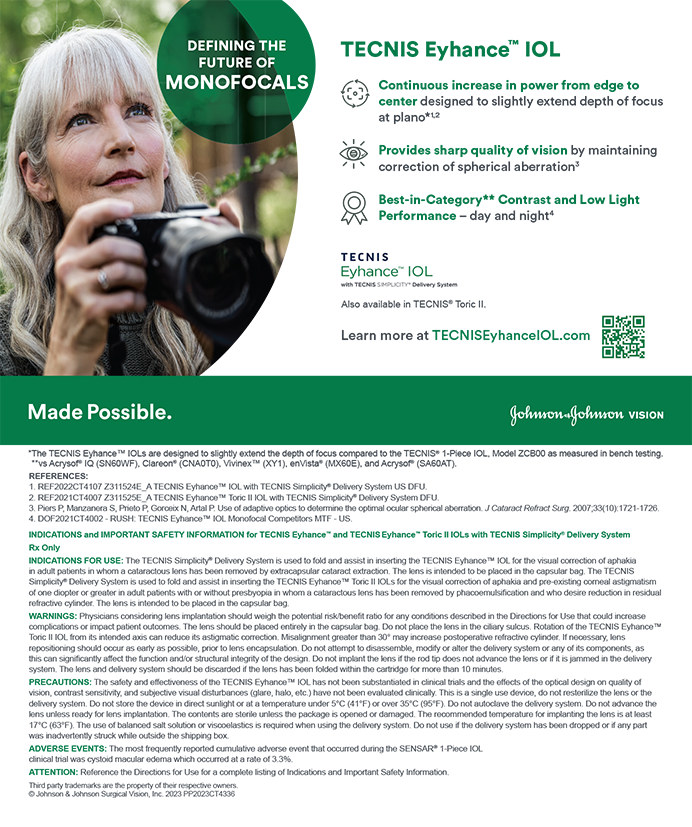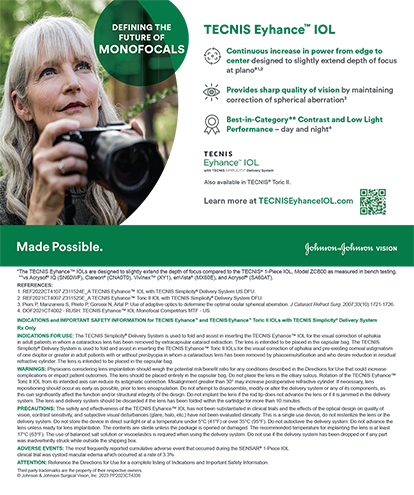The advantages of bimanual microincisional phacoemulsification outweigh any difficulty a surgeon has learning the technique or complications that occur during his early cases. Benefits when compared to coaxial phacoemulsification include enhanced chamber stability (thanks to a more nearly closed system) and better followability of nuclear fragments due to a separation of I/A. Additionally, the surgeon gains access to 360º of the anterior segment with either infusion or aspiration by switching instruments from one hand to the other. He can also use the flow of irrigating fluid as a tool to move material within the capsular bag or anterior chamber, particularly from an open-ended irrigating chopper or manipulator. Finally, microincisional phacoemulsification is associated with a significantly lesser chance of vitreous prolapse in the case of a posterior capsular tear or rupture, thanks to a continual pressurized stream of irrigation in the anterior chamber.
As with any procedure, however, the surgeon must learn how to avoid complications as well as how to manage any problems that happen. A strict attention to detail is required.CONSTRUCTING THE INCISION
The size of the incision varies among surgeons who employ 20-, 19-, and even 18-gauge instrumentation. We prefer the 20-gauge instrument for the greater control it seems to offer. Because the outer diameter of the 20-gauge tip is 0.9mm, the circumference of the tip is 2.8mm, and the incision must measure 1.4mm. A smaller incision stretches, tears, and therefore cannot seal itself. The tip's introduction changes the microincisions from lines to circles, and we want them to resume the configuration of a line when we withdraw the tip. Compromising the corneal collagen by stretching or tearing it reduces the likelihood that the incision will resume its virgin architecture at the end of the case.
Several manufacturers now offer diamond and metal knives specially designed for the construction of 20- or 19-gauge incisions. It behooves the surgeon to purchase and learn to use this instrumentation, whether it is constructed of steel, diamond, or another material.
CREATING THE CAPSULORHEXISPerforming the capsulorhexis represents the greatest hurdle in learning the bimanual technique (Figure 1). Initially, we used a bent-needle cystotome—still a valid technique. Microincisional capsulorhexis forceps, however, permit a greater degree of precision and control, so much so that we advocate their use with any type of incision. The pinch-type initiation of the capsulorhexis is particularly valuable in cases of zonular compromise, because the forces acting on the capsule remain balanced. Even with a severely wrinkled capsule due to traumatic zonular dialysis, these extraordinarily delicate forceps permit moment-by-moment control of the capsulorhexis.
With new-technology IOLs such as the Crystalens (Eyeonics, Inc., Aliso Viejo, CA), we have found the capsulorhexis' size to be an important determinant of the lens' final position and therefore of the patient's postoperative refractive status. Using microincisions enhances the precision of the capsulorhexis' construction, not only because of the improvements in instrumentation, but also because the chamber does not tend to become shallow as often occurs with a 2.5-mm incision due to the burping of viscoelastic.
One is more likely to lose control of the capsulorhexis in highly myopic eyes with large, floppy capsules. Due to these eyes' extremely long anterior chambers, the angle of approach to the anterior capsule is steep. If one notices that the capsulorhexis is tearing farther peripherally than desired, a simple technique for recovering the capsulorhexis involves laying down the flap and pulling it centripetally. This maneuver redirects the capsulorhexis centrally, but it will not suffice if the capsulorhexis has already extended as far as the zonular attachments. In this case, one will likely need to cut the flap with scissors and begin the tear anew. Microincisional intraocular scissors suitable for this purpose are now available.
PERFORMING HYDRODISSECTION AND HYDRODELINEATIONAs described by Dr. Fine,1 the goal of cortical cleaving hydrodissection is to lyse the equatorial capsular/cortical connections. Doing so generally ensures the aspiration of the cortex along with the epinucleus and eliminates the need for I/A as a separate step. Hydrodelineation allows free mobility of the endonucleus within the epinuclear shell and permits endocapsular nuclear disassembly to be cushioned safely by the epinucleus.
One may perform hydrodissection and hydrodelineation just as with standard, small-incision surgery; the risk of compromising the posterior capsule due to excessive pressure is not increased, because the microincisions allow the egress of viscoelastic during this step. Of note, we found that the mean IOP during hydrodissection, as measured in the vitreous cavity of a cadaver eye, varies between 78 and 223mmHg regardless of whether a standard small incision or microincision is employed.2 These were among the highest pressures we recorded during the entire phaco and IOL-implantation procedure. Clearly, if viscoelastic cannot exit the eye, the pressure may rupture the capsule. Users of ophthalmic viscosurgical devices of high zero-shear viscosity should be sure to create a track of BSS from the cannula's tip to the incision in order to establish a path by which the viscoelastic can egress.
DISASSEMBLING THE NUCLEUSEntering the Chamber
A variety of irrigating choppers are now available for microincisional surgery. How to place the blade or paddle of the chopper through the incision is not always immediately apparent. With the Tsuneoka Chopper (Microsurgical Technologies, Redmond, WA), for example, the paddle (shaped like that of a canoe) must be placed parallel to the incision, inserted into the chamber, and then rotated to allow its full entry. Manufacturers usually have instructive surgical videos available.
Placing the phaco tip through the incision may also be harder than it first appears. The surgeon can insert a 30º tip into the incision bevel down and then rock it gently from side to side to permit the instrument's passage into the chamber.
Chopping the NucleusSurprisingly, horizontal and vertical chopping techniques with bimanual phacoemulsification differ little in terms of hand movement from standard, small-incision, coaxial phacoemulsification. Seeing the bulkier irrigating chopper in the eye and getting used to its heavier feel represent the major differences, because the actual chopping techniques are the same.
Using Irrigation as a ToolThe stream of irrigating fluid from the chopper or manipulator can function as an efficient tool within the eye and is one of the most significant advantages of bimanual microincisional phacoemulsification. In particular, washing subincisional endo- or epinuclear material into the range of the phaco tip enhances surgical safety and control.
For instance, during refractive lens exchange with an accommodative IOL in high myopia, maintaining the integrity of the capsule is paramount. Not only would compromising the capsule increase the risk of posterior segment complications, it would also prevent implanting the surgeon's IOL of choice. With bimanual phacoemulsification, no instrument other than a cannula and a stream of fluid ever needs to enter the space within the bag; we can manipulate the soft lenticular material into the anterior chamber with the stream of irrigating fluid and aspirate it safely from the eye with vacuum alone. Thanks to cortical cleaving hydrodissection, we can achieve a clean capsule without ever placing an aspirating tip below the level of the capsulorhexis.
Managing a Posterior Capsular TearIf there is a breach of the posterior capsule, one can generally remove residual nuclear material while maintaining irrigation in the anterior chamber and disallowing vitreous prolapse. With bimanual phacoemulsification, the surgeon can switch from a phaco tip to an aspirator to a vitrectomy cutter if necessary without ever losing chamber stability. After recognizing a tear, one maintains continuous irrigation in the anterior chamber while removing lenticular material from the bag.
Once the bag is clean, the surgeon injects a dispersive viscoelastic at the level of the posterior capsule while continuing irrigation. Only once the viscoelastic has fully tamponaded the break and filled the chamber is the irrigator removed. The surgeon may then insert the IOL into the ciliary sulcus or the capsule through a standard, temporal, clear corneal incision. In the case of sulcus placement, the optic should be pushed posteriorly through the capsulorhexis prior to final cleanup. After removing the viscoelastic, performing the Kenalog (Bristol-Myers Squibb Company, New York, NY) technique described by Scott Burk, MD, PhD, of Cincinnati in his 2001 video for the ASCRS Film Festival will ensure a completely vitreous-free environment in the anterior segment.
CONCLUSIONThe many advantages of bimanual microincisional phacoemulsification are easily accessible to the skilled cataract surgeon. Microincisional IOLs, already available outside the US, will soon create a rush among surgeons to adopt these enhanced techniques. Regardless of the final incision size required for the IOL's insertion, we believe that microincisional phacoemulsification stands on its own as a superior technique to coaxial phacoemulsification.
I. Howard Fine, MD, is Clinical Professor of Ophthalmology at the Casey Eye Institute, Oregon Health & Science University, and he is in private practice at Drs. Fine, Hoffman, & Packer in Eugene, Oregon. Dr. Fine is on the board of directors for Microsurgical Technology, and he receives research and travel support from Eyeonics, Inc. Dr. Fine may be reached at (541) 687-2110; hfine@finemd.com.Richard S. Hoffman, MD, is Clinical Associate Professor of Ophthalmology at the Casey Eye Institute, Oregon Health & Science University, and he is in private practice at Drs. Fine, Hoffman, & Packer in Eugene, Oregon. He states that he holds no financial interest in any of the products or companies mentioned herein. Dr. Hoffman may be reached at (541) 687-2110; rshoffman@finemd.com.
Mark Packer, MD, FACS, is Clinical Assistant Professor of Ophthalmology at the Casey Eye Institute, Oregon Health & Science University, and he is in private practice at Drs. Fine, Hoffman, & Packer in Eugene, Oregon. He has received travel support from Eyeonics, Inc. Dr. Packer may be reached at (541) 687-2110; mpacker@finemd.com.
1. Fine IH. Cortical cleaving hydrodissection. J Cataract Refract Surg. 1992;18:508-512.
2. Khng C, Packer M. Intraocular pressure dynamics during phacoemulsification. Poster presented at: The XXII Congress of the European Society of Cataract and Refractive Surgery; September 18-22, 2004; Paris, France.


